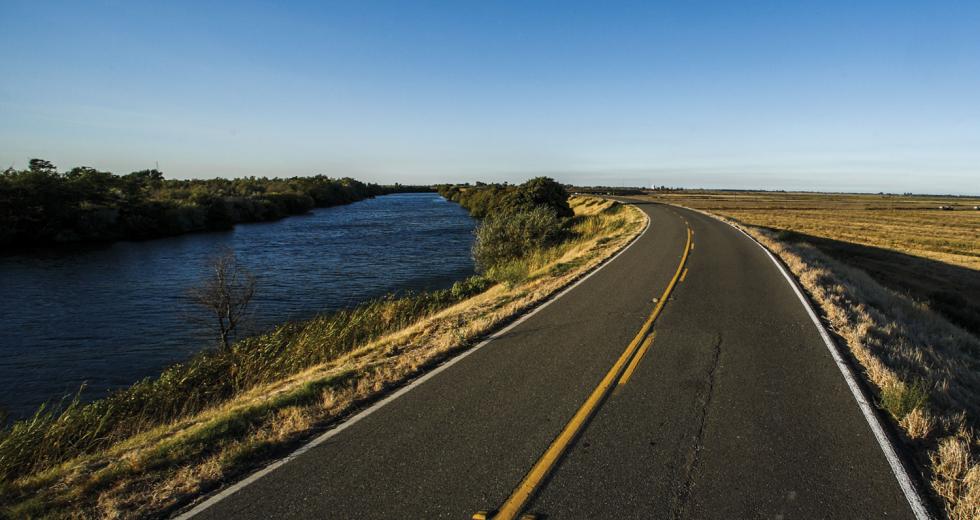Long into early spring, hiking the rocky trail to Loch Leven Lakes required little more than a good pair of boots.
The deep Sierra Nevada snowpack that typically renders the popular Tahoe trail inaccessible until summer was barely a whisper of annual expectations, totaling only 30 percent of normal. Mother Nature eventually came around, ushering in a series of storms that pushed the total to just more than 50 percent of average by late March, though levels farther south remain lower.
But down in the lowlands where California’s mighty economic engine is fueled by snowpack’s runoff, even the late surge caused little joy. A short supply of Sierra snow usually results in reduced spring and summer water shipments to ever-thirsty Central Valley farmers and the hulking metropolises of Southern California and the Bay Area. If the desire of those entities to grab their share of the state’s finite water supply is strong in wet years, it is practically frantic in dry years like this.
Whether the down snow season is a trend or anomaly won’t be known for years, but what we do know is that the lack of precipitation has added to the anxiety of California’s water warriors, who are perpetually jousting over the state’s precious supply.
In the best of times, California water politics is much like a waterway of its own: What you see from the shore pales in comparison to the activity under the surface. Now, with reduced supply running parallel to major legislative efforts to govern its flow, that action often resembles a life-or-death struggle.
None of this is news to Phil Isenberg, chair of the Delta Stewardship Council, the agency created as part of the 2009 water accord championed by former Gov. Arnold Schwarzenegger. The council has numerous responsibilities, but they all pretty much filter into one enormous task: crafting a plan for managing the massive Delta watershed and improving water reliability for downstate users while protecting the Delta’s endangered ecosystem.
The council has released five drafts of its plan and a sixth is being developed. Each has drawn a flurry of protests and condemnations from the various stake-holding factions.
That is, in part, by design.
The council’s drafts are all made open to public comment, and by law the council must reply to those queries. It is no small task. The council’s fifth draft alone received 5,100 pages of comments and submissions from approximately 200 entities delving into all facets of the proposal, from big-picture planning to subsection minutia. It has the unbearable aura of “inside baseball,” the type of wonkish political and scientific matter that causes eyes to glaze over. The law allows officials to consolidate very similar queries, but Isenberg notes — with a smile — that virtually everybody thinks their particular comment or question is worthy of being addressed — individually and at length.
“The feedback we get can be broadly placed into one of two categories,” he said at a recent Senate committee hearing, “those who argue we have gone too far and those who argue we have not gone far enough.”
Some are fishermen whose livelihoods are threatened by the Delta’s continuing deterioration. Others decry that degradation for environmental reasons. Many are staunch advocates for Delta farmers who, rightly in many cases, wonder if their voices will eventually be drowned by the constant cries for water from giant Central Valley agribusinesses. Whatever the purpose, the arguments usually are passionate — and repetitive.
Downstate advocates are passionate, too. Farms, whether corporate monoliths or small family operations, need water to survive. So too does Southern California, home to 25 million people and the heart of the state’s economy. With so much at stake, epic battles are unavoidable.
The latest and loudest salvo in California’s water wars came in late February from the U.S. House of Representatives. It landed in the form of HR 1837, legislation sponsored by Rep. Devin Nunes (R-Visalia) that would ensure Central Valley agribusinesses receive vastly more north state water than current law and conditions allow.
To do that, the measure would enact a multitude of major changes to how the U.S. Bureau of Reclamation, which operates the maze of pumps and canals that comprise the Central Valley Project, manages water shipments from north state rivers to farmers and urban areas south of the Delta. It also would gut the ongoing restoration of the San Joaquin River.
Most notably, the bill would significantly limit the use of the federal Endangered Species Act for reducing those water transfers. It would require the Bureau to operate under guidelines of the 1994 Bay-Delta Accord, a plan for managing the needs of both farmers and the environment, but which long since has been overridden by litigation and legislation. In that regard, it would significantly limit California’s ability to establish and enforce its own water policies, which has some longtime water regulators shaking their heads in disbelief.
“The feedback we get can be broadly placed into one of two categories. Those who argue we have gone too far and those who argue we have not gone far enough.”
Phil Isenberg, chair, Delta Stewardship Council
“This bill completely rewrites the water rights laws of California,” says Isenberg “A lot of people have suggested doing that, but they’ve never suggested it be done so that one geographic region of the state receives priority for a finite water supply over another.”
UC Davis law professor Harrison “Hap” Dunning, a noted California water law expert, says the Nunes bill is “really unprecedented in how it interferes with state law,” calling it “open warfare” on environmental groups. In February, California Attorney General Kamala Harris made the same assertion in a letter to House Speaker John Boehner and other House leaders, claiming the bill’s tenets violate the state sovereignty guaranteed under the U.S. Constitution’s 10th Amendment.
Isenberg notes that HR 1837 would stick a spike through the heart of the Bay Delta Conservation Plan, the controversial joint federal, state and local project that would establish a long-term conservation strategy for the Delta. The BDCP, strongly endorsed by the likes of Gov. Jerry Brown and the Obama administration, is vehemently opposed by many Delta advocates over its proposal to take water directly from the Sacramento River and ship it south around the Delta via canal or tunnel.
Delta residents and environmental advocates claim the so-called “peripheral canal” — which voters overwhelmingly rejected in 1982 — would devastate the Delta ecosystem. But though some people might cheer the BDCP’s death, Isenberg says they wouldn’t be nearly as thrilled to know the law could also stamp out things they like, such as flood control and other ecosystem projects in their area.
“Were this legislation to become law, it would effectively halt most environmental protections in the state of California that pertain to our water supply system through the Delta and lead to 40 to 50 years of litigation,” he says.
But the bill has its supporters as well. Not surprisingly, they include major water agencies from the Central Valley, which stand to benefit the most should the bill somehow become law. That prospect now seems dim, given that it must get through the Democrat-controlled U.S. Senate, where powerful California Senators Dianne Feinstein and Barbara Boxer, both Democrats, oppose it. Even if it were to survive there, President Obama has indicated he would veto the bill.
Feinstein has a close relationship with the Central Valley’s largest agricultural players and has previously shown a willingness to work on measures that would grant them more water more often. But in late March, Feinstein emphatically rejected speculation that she would support the bill or work on a compromise bill of her own. She called the Nunes bill “an incredible distraction and an impediment to the cooperation necessary to solve California’s water supply challenges.”
That could all change, however, should the GOP reclaim the Senate or White House in the fall.
California State Senate President pro Tem Darrell Steinberg, a Sacramento Democrat and another of the architects of the 2009 water accord, says he hasn’t discussed the matter with Feinstein. Steinberg regularly hears from the state’s many water interests, and he laments any possibility that federal intervention could upend the deal it took him and his colleagues so much time to craft.
“Many people consider the water deal of 2009 a once-in-several-decades advance, and I wouldn’t want to see anything stop our progress,” he says.
But measures like HR 1837 are far from Steinberg’s only concern surrounding that deal, or even the most immediate one. The accord also called for an $11.2 billion bond measure to pay for much of its conservation and infrastructure upgrades. But the state’s economic woes forced lawmakers to take the bond off the November 2010 ballot in hopes the economy would have improved enough by this year to make it more palatable to voters. Now, with the economy still lukewarm, Steinberg says, “the bond measure will, in all probability, get moved” to the 2014 ballot.
If and when the bond appears on the ballot, it is also likely to be much smaller than the current proposal. Steinberg acknowledges there is an effort to “bring the bond under $10 billion,” theoretically giving it a better chance with voters. But doing that would take a two-thirds majority vote of lawmakers, a daunting challenge at best. Though Steinberg says “we did it once and we can do it again,” few observers share his optimism.
For all the uncertainty over the bond it is only one of the dangerous currents California’s water managers must navigate in the coming months. And in spite of the constant strife and chaos surrounding their tasks, they are making some headway toward completing major components of the state’s water management strategy.
The seventh and presumably final draft of the Delta Stewardship Council’s master plan — long past its original Jan. 1 due date — should be out by late summer. The BDCP has also released the initial technical analysis of its conservation blueprint for the Delta — 10,000 pages worth — opening it to independent scientific review and public comments.
Predicting how either of those two processes will come out is folly. Arguments continue to rage over things such as Delta flow levels, “covered actions” (projects in or outside the Delta that might impact the watershed, thus being covered under the Delta Stewardship Council’s regulations) and a host of other issues. Isenberg says there is now talk of bringing some of the many vested interests together to form a joint powers authority to oversee Delta management. Whether it becomes reality or stays just talk may take years to determine.
With all that, it is easy to question whether California’s perpetual water wars will ever end. Tim Quinn, executive director of the Association of California Water Agencies, which represents water agencies on both ends of the north/south water tug-o-war, remains optimistic.
“If the 2009 water deal proves anything, it is that California
democracy can solve really complex problems once in a while,” he
says. “We’re definitely getting closer on this one.”
Recommended For You
Water Wars
Sacramento-San Joaquin Delta
For nearly 50 years California boasted the nation’s largest, most successful water system. Water flowed through the Gov. Edmund G. Brown California Aqueduct to San Joaquin Valley farms and southern California homes.

Water Wise Man
Engineer David Ford gives unpopular answers to flood of questions
Being the bearer of unwelcome news rarely makes you the most popular person in town, particularly when it comes to flood control. But it doesn’t worry David Ford, one of the most trusted figures on California’s sometimes-contentious flood control scene and a man with a knack for speaking what Pulitzer Prize-winning journalist Frank Hagar once called “the truth that men prefer not to hear.”



